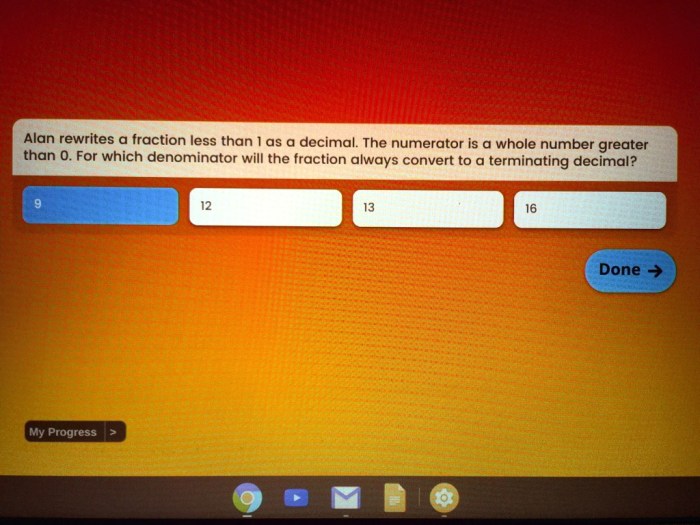Alan rewrites a fraction less than 1 as a decimal – In the realm of mathematics, Alan embarks on a journey to rewrite fractions less than 1 as decimals, unlocking a deeper understanding of numerical representations. This guide delves into the intricacies of this conversion process, empowering readers with the knowledge to navigate fractions and decimals with ease.
As we delve into the nuances of this topic, we will explore the methods, applications, and significance of converting fractions to decimals. Prepare to witness the transformation of complex fractions into their decimal counterparts, unveiling the hidden patterns that govern numerical conversions.
Converting Fractions to Decimals: Alan Rewrites A Fraction Less Than 1 As A Decimal

Converting fractions to decimals is a fundamental mathematical operation that involves representing a fraction as a number in decimal notation. Decimals provide a more precise and convenient way to express fractions, especially when dealing with measurements, calculations, and real-world applications.
Understanding the Conversion
A fraction represents a part of a whole, expressed as a ratio of two integers. The numerator (top number) indicates the number of parts taken, while the denominator (bottom number) indicates the total number of parts. To convert a fraction to a decimal, we divide the numerator by the denominator.
For example, the fraction 1/2 represents half of a whole. To convert 1/2 to a decimal, we divide 1 by 2, which gives us 0.5. Therefore, 1/2 is equivalent to 0.5 in decimal notation.
Rewriting a Fraction Less Than 1
A fraction less than 1 is a fraction where the numerator is smaller than the denominator. To rewrite a fraction less than 1 as a decimal, we follow these steps:
- Place a decimal point after the numerator.
- Add zeros to the numerator, as needed, to create a dividend that is divisible by the denominator.
- Perform long division, dividing the dividend by the denominator.
- The quotient is the decimal representation of the fraction.
For example, to convert 1/4 to a decimal, we place a decimal point after 1, add a zero to the numerator, and divide 10 by 4. The quotient is 2.5, so 1/4 is equivalent to 0.25 in decimal notation.
Methods for Conversion, Alan rewrites a fraction less than 1 as a decimal
There are two common methods for converting fractions to decimals:
- Long Division Method:As described above, this method involves dividing the numerator by the denominator using long division.
- Equivalent Fraction Method:This method involves finding an equivalent fraction with a denominator of 10, 100, 1000, and so on, and then removing the denominator to obtain the decimal representation.
For example, to convert 1/4 to a decimal using the equivalent fraction method, we can find an equivalent fraction with a denominator of 100 by multiplying both the numerator and denominator by 25. This gives us 25/100, which simplifies to 0.25 in decimal notation.
FAQs
What is the significance of converting fractions to decimals?
Converting fractions to decimals allows for easier comparison, calculation, and application in real-world scenarios, where decimal representations are widely used.
Can all fractions be rewritten as terminating decimals?
No, only fractions with denominators that are factors of 10 can be rewritten as terminating decimals. Others result in repeating decimals.

